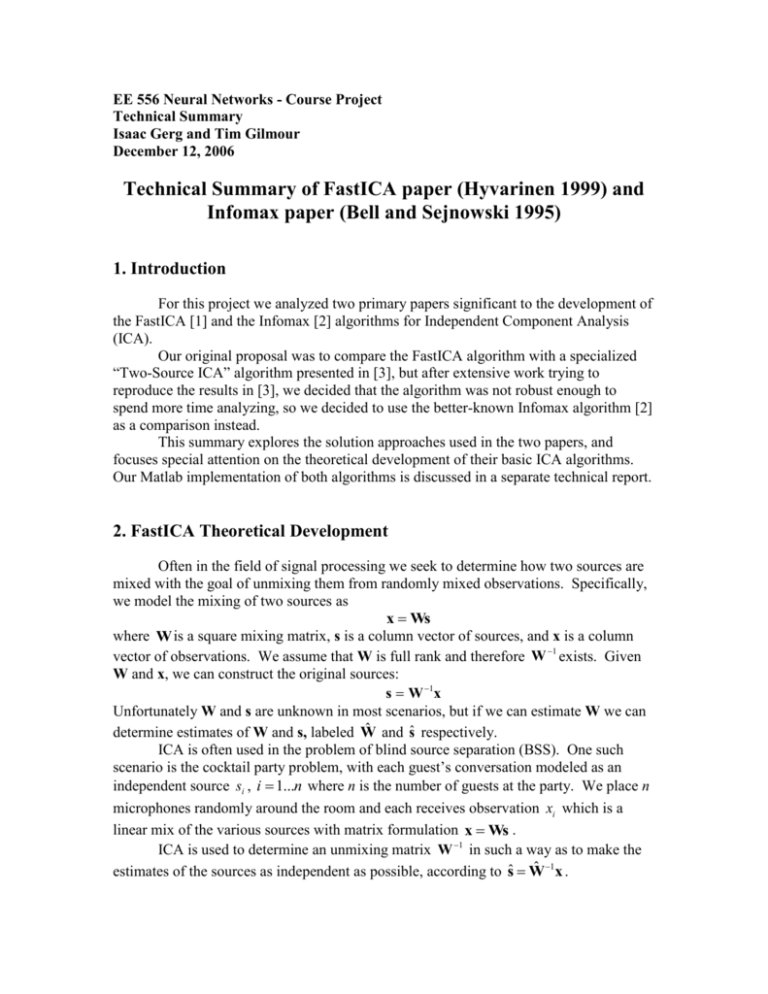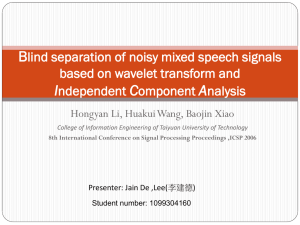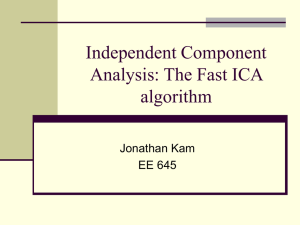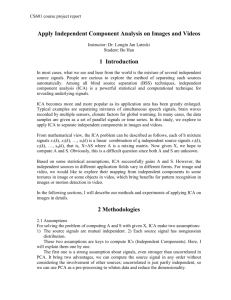EE 556 Neural Networks
advertisement

EE 556 Neural Networks - Course Project
Technical Summary
Isaac Gerg and Tim Gilmour
December 12, 2006
Technical Summary of FastICA paper (Hyvarinen 1999) and
Infomax paper (Bell and Sejnowski 1995)
1. Introduction
For this project we analyzed two primary papers significant to the development of
the FastICA [1] and the Infomax [2] algorithms for Independent Component Analysis
(ICA).
Our original proposal was to compare the FastICA algorithm with a specialized
“Two-Source ICA” algorithm presented in [3], but after extensive work trying to
reproduce the results in [3], we decided that the algorithm was not robust enough to
spend more time analyzing, so we decided to use the better-known Infomax algorithm [2]
as a comparison instead.
This summary explores the solution approaches used in the two papers, and
focuses special attention on the theoretical development of their basic ICA algorithms.
Our Matlab implementation of both algorithms is discussed in a separate technical report.
2. FastICA Theoretical Development
Often in the field of signal processing we seek to determine how two sources are
mixed with the goal of unmixing them from randomly mixed observations. Specifically,
we model the mixing of two sources as
x Ws
where W is a square mixing matrix, s is a column vector of sources, and x is a column
vector of observations. We assume that W is full rank and therefore W 1 exists. Given
W and x, we can construct the original sources:
s W 1 x
Unfortunately W and s are unknown in most scenarios, but if we can estimate W we can
determine estimates of W and s, labeled Ŵ and ŝ respectively.
ICA is often used in the problem of blind source separation (BSS). One such
scenario is the cocktail party problem, with each guest’s conversation modeled as an
independent source si , i 1...n where n is the number of guests at the party. We place n
microphones randomly around the room and each receives observation xi which is a
linear mix of the various sources with matrix formulation x Ws .
ICA is used to determine an unmixing matrix W 1 in such a way as to make the
ˆ 1x .
estimates of the sources as independent as possible, according to sˆ W
The development of the FastICA algorithm begins with the definition of
differential entropy:
H (y ) f (y ) log f (y )dy
From this definition, the concept of negentropy can be defined.
J (y ) H (y gauss ) H (y )
Negentropy has a useful property in that it is invariant for linear transforms, such
as those seen in the cocktail party. Negentropy is also interpreted as a measure of
nongaussianity. The notion of mutual information between several random variables
arises from differential entropy. FastICA uses this idea of mutual information to express
the natural measure of dependent between random variables. Expressing mutual
information using negentropy and constraining the variables to be uncorrelated, one gets
I ( y1 , y2 ,..., yn ) J (y ) J ( yi )
i
From this, it is possible to construct an ICA algorithm which finds an unmixing
matrix W such that the mutual information of the output unmixed estimated signals is
minimized. It also possible to show that this model is similar to finding the directions in
which the negentropy is maximized. This is the method specifically used by FastICA.
In order to find the directions where the negentropy is maximized, one must
measure the negentropy of a random variable. Often, an approximation is used of the
following form:
J ( yi ) c[ E{G ( yi )} E{G (v)}]2
where G is a non-quadratic contrast function, c is an ignorable constant, and v is a
random variable distributed normally with unit variance and zero mean. A common
choice for the function G is:
G1 (u) log cosh( u)
g1 (u) G(u)1 tanh( u)
We assume yi is of also zero mean and unit variance. To find one independent
component, we maximize the function JG given by
J G (w ) [ E{G (w T x)} E{G (v)}]2
To determine all the independent components, this approach is extended. From
the definition of mutual information, the mutual information among random variables is
minimized when the sum of the negentropies is maximized. Therefore, if one maximizes
over the sum of all the negentropy estimates, and using the decorrelation constraint, one
can obtain the optimization problem below:
n
maximize
J
i 1
G
(w i ) with respect to w i , i 1,..., n
under constraint E{(wTk x)(wTj x)} jk
The authors of FastICA recommend the use of a tailored contrast function only when one
wants to fine-tune the performance of the algorithm.
To maximize the resulting optimization problem, one could use the familiar
gradient descent algorithm often used in the training of neural networks. This results in
an algorithm that can operate on time domain data in real-time. This method has the
advantage of adaptability in the presence of non-stationary environments. However, use
of gradient descent often leads to slow convergence and its speed generally depends on
the learning rate parameter. Thus, a bad learning rate parameter can destroy convergence
and even lead to large oscillation around the optimal solution. To defeat the perils of
gradient descent, the authors of FastICA introduced fixed-point iteration algorithms.
These algorithms are able to adapt faster and more reliably than their gradient decent
counterparts. However, the downfall is that they must operate in batch mode thus
requiring buffers and other complications to process fast, real-time data.
To derive the fixed-point algorithm, we construct an optimization problem. The
optima of the system are points at which
E{wg (wT x)} w 0 ,
where E{w 0 xg (w 0 x)} and w 0 is the optimum value of w . This result is derived
from the Kuhn-Tucker conditions as denoted in [5]. FastICA chooses to solve this
system using Newton’s method. For a single variable this method is of the following
form:
f ( xn )
xn1 xn
f ( xn )
For the case of many variables [6], we get
xn1 xn f (xn ) J f 1 (xn )
T
T
Thus, instead of dividing by f (x n ) , we multiply by the inverse of the Jacobian of f :
J f (w) E{xxT g (w T x)} I
To simplify the inversion of the Jacobian, the first term is approximated using the fact
that the data is whitened:
E{xxT g (wT x)} E{g (wT x)}I
This result gives an approximate Newton iteration:
E{xg (wT x)} w
w w
E{g (wT x)}
w
w*
w
We can factor by E{xg (wT x)} to get the final fixed-point algorithm:
w E{xg (wT x)} E{g (wT x)}w
w*
w
w
Optimizations that use Newton’s method may suffer from convergence problems.
To mitigate this problem, one may multiply the update term by a learning rate parameter
to improve convergence. This gives us a stabilized fixed-point algorithm
E{xg (wT x)} w
w w (t )
T
E{g (w x)}
w*
w
w
where (t ) is the learning rate parameter and often a small constant (e.g. (t ) =0.1 or
0.01) though it can also depend on time (e.g. (t ) = e 0.09t ).
This learning rule gives us the optimization scheme for determine one
independent component. To obtain the other components, n neurons may be used, but
their outputs must be decorrelated after every iteration to prevent more than one of them
from converging to the same maxima.
The authors of FastICA present three methods for achieve this: Gram-Schmidt
orthogonalization, explicit eigenvector decomposition, and Potter’s method (which
converges by implicitly decomposing the matrix). We will describe here only GramSchmidt orthogonalization. Using this method, we estimate an independent component,
using a single unit w p1 . Then, we subtract from wTp1 the projections wTp1w j w j ,
j=1,…p. We repeat this process for each component estimated. For pre-sphered data:
p
w p1 w p1 wTp1w j w j
(17)
j 1
w p1
w p1
w p1
The vectors w1 through w p make up the mixing matrix W. Finally, the mixing matrix is
inverted to determine the unmixing matrix.
3. FastICA Experimentation
The authors performed experiments to investigate three facets of their ICA
algorithm. The first test addressed the robustness of the contrast functions chosen by the
algorithm. The second test addressed the asymptotic variance of the estimators. Finally,
the third test addressed the speed of convergence in light of using Newton iterations
instead of tradition gradient decent.
The authors conducted the first test by generating four artificial sources (two
super-Gaussian, two sub-Gaussian), mixing them with random matrices (elements drawn
from a normal Gaussian distribution), and adding four outliers at random locations in the
data. The algorithm then operated on the simulated data and its output was compared
against a run using the same data but without the outliers. The authors found, in general,
the estimates based on the kurtosis contrast function to be worse the other two with the
best estimate being the exponentially based contrast function.
The authors conducted the second test by running their algorithm using the three
different contrast functions on a four-source mix in order to unmix one specific source.
The sources were drawn from three identical, independent, distributions: uniform,
Laplace, and the third power of a Gaussian variable. The experiment was run 1000 times
and averaged to determine the final error measurement. This was computed by
calculating the mean absolute differences between the recovered component and the
original source component. The authors found that the kurtosis contrast function
performed worse for the super-Gaussian independent components and performed well
only for the sub-Gaussian components. Of the other two contrast functions, neither
performed exceptionally better than the other.
The authors then added Gaussian noise and reran the tests. They found that the
kurtosis contrast function did not perform well for any of the mixes (including ones
derived from sub-Gaussian sources). The remaining two contrast functions appeared to
work well in this environment.
Finally, the third tests investigated the speed of convergence of the FastICA
algorithm. The authors conducted this test by generating four independent components
(two of sub-Gaussian origin and two of super-Gaussian origin), mixing them, and then
running their algorithm. The algorithm used was the “symmetrical decorrelation” method
described in Eq. (26) of their paper. This method simultaneously estimates all the
independent components during each iteration. The data was 1000 points long and all of
it was used every iteration. The authors found that for all three contrast functions, on
average, only three iterations were necessary to achieve the maximum accuracy allowed
by the data.
These three tests clearly demonstrated the algorithm’s ability to separate the
independent components well and in a computationally efficient manner.
4. Infomax Theoretical Development
The Neural Computation paper by Bell and Sejnowski entitled “An informationmaximization approach to blind separation and blind deconvolution” [2] developed a
paradigm for principled information-theoretic design of single-layered neural networks
for blind separation of sources.
The paper is basically an extension of the infomax principle to a network of nonlinear units that is applied to solve the BSS problem of N receivers picking up linear
mixtures of N source signals. If the hyperbolic tangent or logistic sigmoid are used as the
unit activation functions, the Taylor expansion of the function demonstrates implicit
inclusion of higher-than-second-order statistics. The use of such higher order statistics
(e.g. fourth order cumulants) is common in the ICA literature, though somewhat ad hoc.
This paper provides a sound information-theoretic basis and an associated learning rule
for their implicit use in a neural network approach.
The Infomax version of ICA developed by Bell and Sejnowski seeks to maximize
the mutual information between the output Y of a neural network and its input X. The
weight matrix of the neural network is learned so as to approximate the unknown mixing
matrix W. The mutual information in general between the input and output of the
network is:
I (Y , X ) H (Y ) H (Y X )
where H(Y) is the entropy of the output and H(Y|X) is the entropy of the output given the
input X. Continuous signals require the use of differential entropies rather than absolute
entropies, but since we are using the difference between differential entropies the
reference term disappears (cf. [4], p. 488).
For a deterministic system Y = G(X) + N where G is an invertible mapping with
parameter w and N is additive noise, the entropy H(Y|X) is simply the entropy H(N) of the
noise in the system, which does not depend upon w. Thus for this system:
I (Y , X )
H (Y )
w
w
meaning that the mutual information between the inputs and the outputs can be
maximized by maximizing the entropy of the outputs alone. The information capacity in
the model used by Bell and Sejnowski is limited by the saturation of the activation
function rather than by noise.
This deterministic system with additive noise is used as the system model for the
Infomax ICA algorithm, which attempts to estimate the mixing parameter w (without
modeling the noise). The ICA approach is better able to separate blind linear mixtures of
the data than second-order techniques, which for memoryless systems can find only
symmetric decorrelation matrices. ICA uses higher order statistics of the data, which
generally provides better separation than first- and second-order approaches like PCA
(unless the input signals are jointly gaussian).
The infomax principle is described for non-linear units in the paper as follows:
"when inputs are to be passed through a sigmoid function, maximum information
transmission can be achieved when the sloping part of the sigmoid is optimally lined up
with the high density parts of the inputs" ([2], p. 2).
This principle is directly adapted into a gradient ascent procedure. For a network
with input vector x , weight matrix W , bias vector w 0 and a monotonically transformed
output vector y g ( Wx w 0 ) , the multivariate probability density function (pdf) of y
is given in terms of the pdf of x as:
f (x)
f y (y ) x
J
where J is the absolute value of the determinant of the Jacobian matrix of partial
derivatives:
y1
y1
x x
n
1
J det
yn yn
x1
xn
The differential joint entropy of the outputs is defined to be:
H (y ) E ln f y (y )
f ( x)
E ln x
J
E ln J Eln f x (x)
where only the term Eln J depends on the weights W . To maximize the joint entropy
of the outputs, we can update the weight matrix using gradient descent:
W
H
ln J
W W
N
y
ln (det W ) i
W
i 1 ui
N
y
(det W )
ln i
W
W i 1 ui
N
(adj W )T
y
ln i
det W
W i 1 ui
N
y
ln i
W i 1 ui
This can be further simplified using the derivative of the activation function y g (u ) ,
1
once the function is chosen. For the logistic sigmoid function yi
, we get
1 eui
N y i
yi
yi (1 yi ) and thus each component of the
term is given by
ui
W i 1 u i
( WT ) 1
y
ln i x j (1 2 yi ) .
wij ui
Similarly, the update for the bias weight is:
H
w 0
ln J
w 0 w 0
N
y
ln (det W) i
w 0
i 1 ui
N
y
ln i
w 0 i 1 ui
Simplifying for the logistic sigmoid function gives: w 0 1 2y where 1 is a vector of
ones.
After deriving this weight update equation for basic memoryless ICA blind
separation, Bell and Sejnowski extended their algorithm to investigate more general
deconvolution separations. This summary paper will only briefly describe these
extensions.
Bell and Sejnowski define the Jacobian for a time series that has been convolved
with a causal filter and then passed through a nonlinear function. The same infomax
principle is then invoked to update the weights of a neural network which is attempting to
decorrelate the past input from the present output (i.e., a whitening transform).
Similarly, an update is derived for the infomax time-delay estimate in a scenario
where the signal is delayed by an unknown time. Using the similar gradient-descent
procedure, the update rule attempts to phase-synchronize signals with similar frequency
content.
Finally, the authors describe an extension of their algorithm in which the
nonlinear activation function is automatically customized so that the high-density parts of
the input pdf are matched to the highly sloping parts of the function. They suggest a
generalized sigmoid function which can be substituted into their earlier algorithm when
the parameters for the (strictly unimodal) input pdf are easily available.
5. Infomax Experimentation
Bell and Sejnowski performed separation of audio signals to demonstrate their
Infomax ICA algorithm. The memoryless “cocktail-party” scenario was demonstrated
with up to ten sources. Independent audio signals were recorded and combined with a
random mixing matrix, then unmixed by the Infomax algorithm (coded in Matlab). One
key insight was to randomly permute the mixed signal in time before training on it, to
make the statistics stationary. The authors also used “batches” of up to 300 samples to
speed convergence of their weight matrices.
For two sources, 5 10 4 iterations were sufficient for convergence. Five sources
required 1 10 6 iterations, and the convergence number for ten sources was not given.
Recovered signal quality was good with typical output SNRs from 20 dB to 70 dB. The
ICA algorithm had difficulty whenever the mixing matrix was nearly singular (for
obvious numerical reasons) and when more than one of the sources were exactly
gaussian-distributed (a standard limitation of ICA). The authors pointed out that illconditioned mixing matrices simply delayed convergence.
The authors also tested their Infomax blind deconvolution procedure. The first
example was a single signal which the 15-tap algorithm whitened instead of simply
returning unchanged. This behavior is expected due to the information-maximizing
approach (use of all frequencies maximizes channel capacity). The second example was
a 25-tap “barrel” convolution, which the algorithm successfully learned and removed.
The third 30-tap example used multiple echoes, which the algorithm again successfully
removed. All examples converged in approximately 70000 iterations.
The authors also mentioned (but did not present graphical results for) tests of
simultaneous ICA separation and deconvolution, which were allegedly successful.
6. Discussion and Conclusions
Both the FastICA and the Infomax approaches apply information-theoretic
analyses to try to find independent components. Haykin suggests that both models fall
under the same broad category of gradient ascent/descent of various types of mutual
information (See Figure 1, directly adapted from [4], page 498, Figure 10.2).
Figure 1 – Two different information-theoretic approaches to ICA
Both models can be understood by the equation relating the joint entropy of the
output variables to their individual entropies and their mutual information:
H ( y1 , y2 ) H ( y1 ) H ( y2 ) I ( y1 , y2 )
The Infomax algorithm presented here uses gradient descent to maximize
H ( y1 , y2 ) directly, whereas the FastICA algorithm seeks to minimize I ( y1 , y2 ) . These
approaches are thus directly related. However, the Infomax algorithm is not guaranteed
to reach the minimum of I ( y1 , y2 ) because of interference from the individual entropies
H ( yi ) . Bell and Sejnowski’s paper describe specific pathological scenarios in which
these individual entropies can defeat the Infomax algorithm, when basically the input
pdfs are not well matched to the activation nonlinearities. This problem can be
ameliorated by their method of automatically customizing a generalized sigmoid as the
activation function.
Limitations to both methods are typical for all ICA algorithms, such as the
difficulty of separating nearly-gaussian sources or sources with lots of added gaussian
noise.
Since FastICA requires that the data be whitened as a pre-processing step, it
would be computationally advantageous if a way could be found to directly process
unwhitened data. Some work along these lines was reported in [3].
An extension of FastICA is nonnegative FastICA, which uses the knowledge that
in some physical scenarios certain sources do not negatively contribute to a mix. The
constraints can then be imposed that the estimated mixing matrix contains only
nonnegative values and the mixing weights for each observation sum to one. The latter
idea address the conservation of energy principle in that the no energy is lost of gained in
the mixing process.
The Infomax algorithm could be improved by applying the “natural gradient”
method [7] to eliminate taking the inverse of the weight matrix in the Infomax weightupdate equation, thus speeding up the algorithm.
Additionally, the Infomax algorithm could be extended to multi-layer neural
networks for increased representational power (though perhaps slower convergence).
The Infomax deconvolution algorithm could be improved by adding a simple
linear adaptive filter at the input to estimate any time delay, followed by the nonlinear
neural network.
Both algorithms in their presented form require the number of source be equal or
less than the number of observations. In many physical instances, there are more or less
sources than observations. The authors indicate that further refinement is being done on
both algorithms in this area.
7. References
[1] Hyvarinen, A., Fast and Robust Fixed-Point Algorithms for Independent Component
Analysis. IEEE Transactions on Neural Networks. Vol 10. Num 3. Pps. 626-634.
1999
[2] Bell, A.J. and T.J. Sejnowski. An information-maximization approach to blind
separation and blind deconvolution. Neural Computation, Volume 7(6). 1995. Pps.
1004-1034.
[3] Yang, Zhang, Wang. A Novel ICA Algorithm For Two Sources. ICSP Proceedings
(IEEE). 2004. Pps. 97-100.
[4] Haykin, Simon. Neural Networks: a comprehensive foundation, 2nd edition. PrenticeHall: Upper Saddle River, New Jersey. 1999.
[5] Tuner, P. Guide to Scientific Computing, 2nd Edition. CRC Press: Boca Raton, FL.
2001. p. 45.
[6] Luenberger, D. Optimization by Vector Space Methods, Wiley: New York, 1969.
[7] Amari, S., Cichocki, A., Yang, H.H. “A New Learning Algorithm for Blind Signal
Separation,” in Advances in Neural Information Processing Systems, D.
Touretzky, M. Mozer, M. Hasselmo, Eds. MIT Press: Cambridge, MA. 1996. pp.
757-763.






